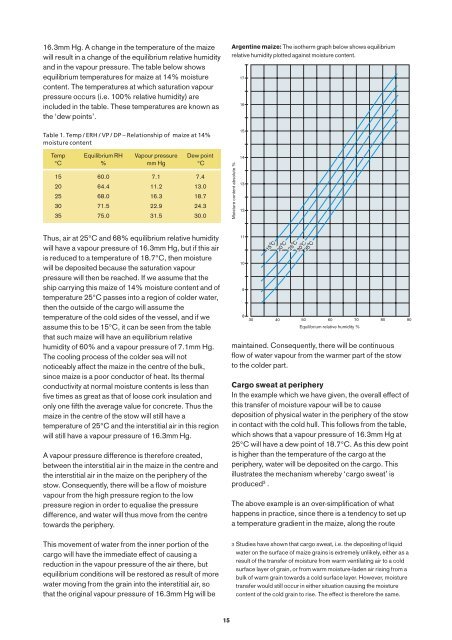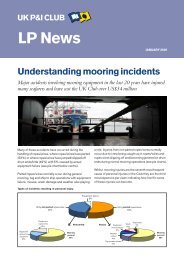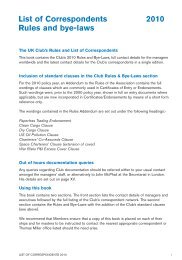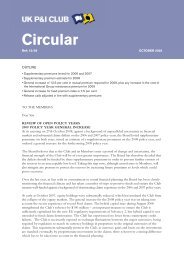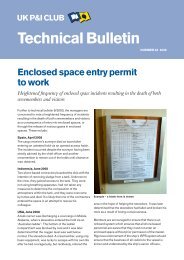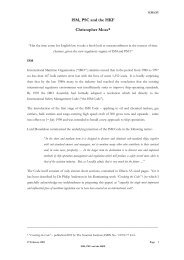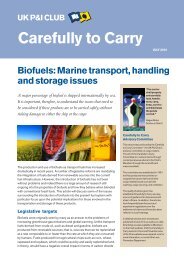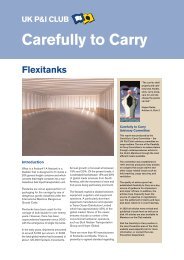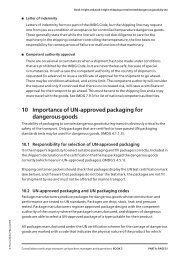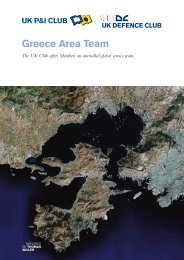Bulk Matters - UK P&I
Bulk Matters - UK P&I
Bulk Matters - UK P&I
Create successful ePaper yourself
Turn your PDF publications into a flip-book with our unique Google optimized e-Paper software.
16.3mm Hg. A change in the temperature of the maize<br />
will result in a change of the equilibrium relative humidity<br />
and in the vapour pressure. The table below shows<br />
equilibrium temperatures for maize at 14% moisture<br />
content. The temperatures at which saturation vapour<br />
pressure occurs (i.e. 100% relative humidity) are<br />
included in the table. These temperatures are known as<br />
the ‘dew points’.<br />
Table 1. Temp / ERH / VP / DP – Relationship of maize at 14%<br />
moisture content<br />
Temp Equilibrium RH Vapour pressure Dew point<br />
°C % mm Hg °C<br />
15 60.0 7.1 7.4<br />
20 64.4 11.2 13.0<br />
25 68.0 16.3 18.7<br />
30 71.5 22.9 24.3<br />
35 75.0 31.5 30.0<br />
Argentine maize: The isotherm graph below shows equilibrium<br />
relative humidity plotted against moisture content.<br />
Moisture content absolute %<br />
17<br />
16<br />
15<br />
14<br />
13<br />
12<br />
Thus, air at 25°C and 68% equilibrium relative humidity<br />
will have a vapour pressure of 16.3mm Hg, but if this air<br />
is reduced to a temperature of 18.7°C, then moisture<br />
will be deposited because the saturation vapour<br />
pressure will then be reached. If we assume that the<br />
ship carrying this maize of 14% moisture content and of<br />
temperature 25°C passes into a region of colder water,<br />
then the outside of the cargo will assume the<br />
temperature of the cold sides of the vessel, and if we<br />
assume this to be 15°C, it can be seen from the table<br />
that such maize will have an equilibrium relative<br />
humidity of 60% and a vapour pressure of 7.1mm Hg.<br />
The cooling process of the colder sea will not<br />
noticeably affect the maize in the centre of the bulk,<br />
since maize is a poor conductor of heat. Its thermal<br />
conductivity at normal moisture contents is less than<br />
five times as great as that of loose cork insulation and<br />
only one fifth the average value for concrete. Thus the<br />
maize in the centre of the stow will still have a<br />
temperature of 25°C and the interstitial air in this region<br />
will still have a vapour pressure of 16.3mm Hg.<br />
A vapour pressure difference is therefore created,<br />
between the interstitial air in the maize in the centre and<br />
the interstitial air in the maize on the periphery of the<br />
stow. Consequently, there will be a flow of moisture<br />
vapour from the high pressure region to the low<br />
pressure region in order to equalise the pressure<br />
difference, and water will thus move from the centre<br />
towards the periphery.<br />
This movement of water from the inner portion of the<br />
cargo will have the immediate effect of causing a<br />
reduction in the vapour pressure of the air there, but<br />
equilibrium conditions will be restored as result of more<br />
water moving from the grain into the interstitial air, so<br />
that the original vapour pressure of 16.3mm Hg will be<br />
11<br />
10<br />
9<br />
o 20 C<br />
15 C<br />
o 25 o C<br />
30 o C<br />
35 o<br />
C<br />
8<br />
30 40 50 60 70 80 90<br />
Equilibrium relative humidity %<br />
maintained. Consequently, there will be continuous<br />
flow of water vapour from the warmer part of the stow<br />
to the colder part.<br />
Cargo sweat at periphery<br />
In the example which we have given, the overall effect of<br />
this transfer of moisture vapour will be to cause<br />
deposition of physical water in the periphery of the stow<br />
in contact with the cold hull. This follows from the table,<br />
which shows that a vapour pressure of 16.3mm Hg at<br />
25°C will have a dew point of 18.7°C. As this dew point<br />
is higher than the temperature of the cargo at the<br />
periphery, water will be deposited on the cargo. This<br />
illustrates the mechanism whereby ‘cargo sweat’ is<br />
produced 3 .<br />
The above example is an over-simplification of what<br />
happens in practice, since there is a tendency to set up<br />
a temperature gradient in the maize, along the route<br />
3 Studies have shown that cargo sweat, i.e. the depositing of liquid<br />
water on the surface of maize grains is extremely unlikely, either as a<br />
result of the transfer of moisture from warm ventilating air to a cold<br />
surface layer of grain, or from warm moisture-laden air rising from a<br />
bulk of warm grain towards a cold surface layer. However, moisture<br />
transfer would still occur in either situation causing the moisture<br />
content of the cold grain to rise. The effect is therefore the same.<br />
15


